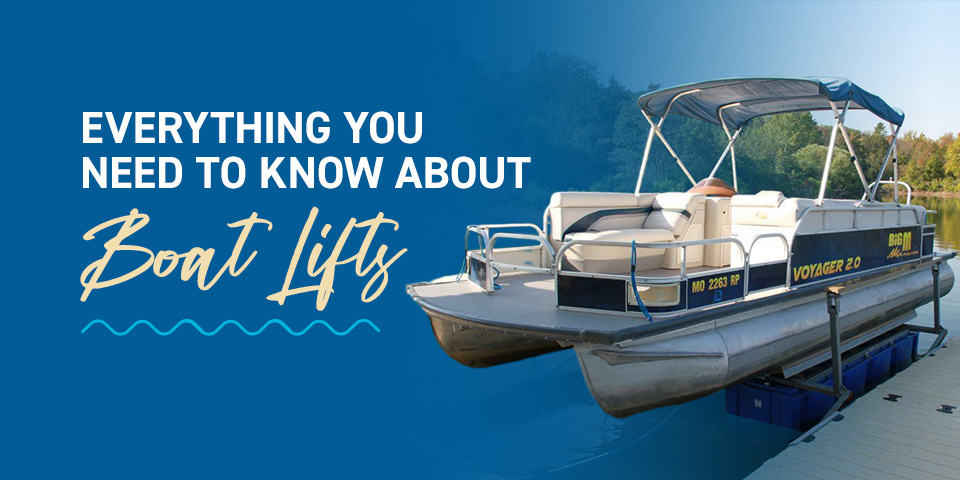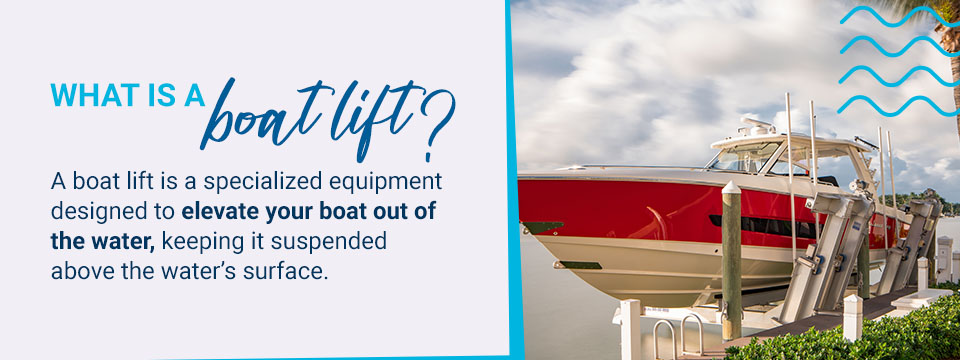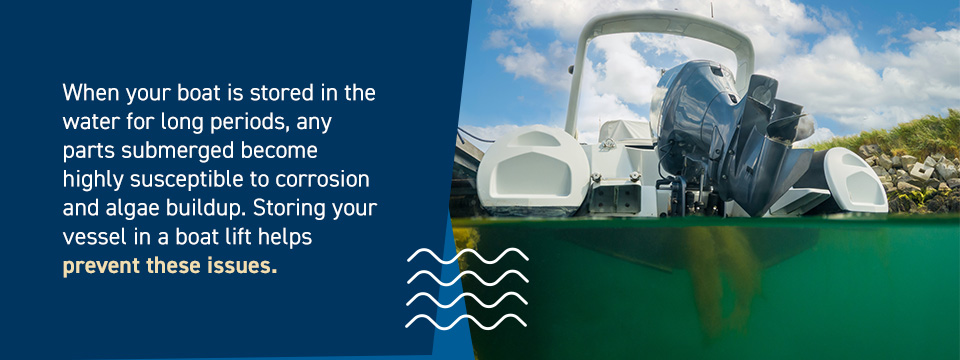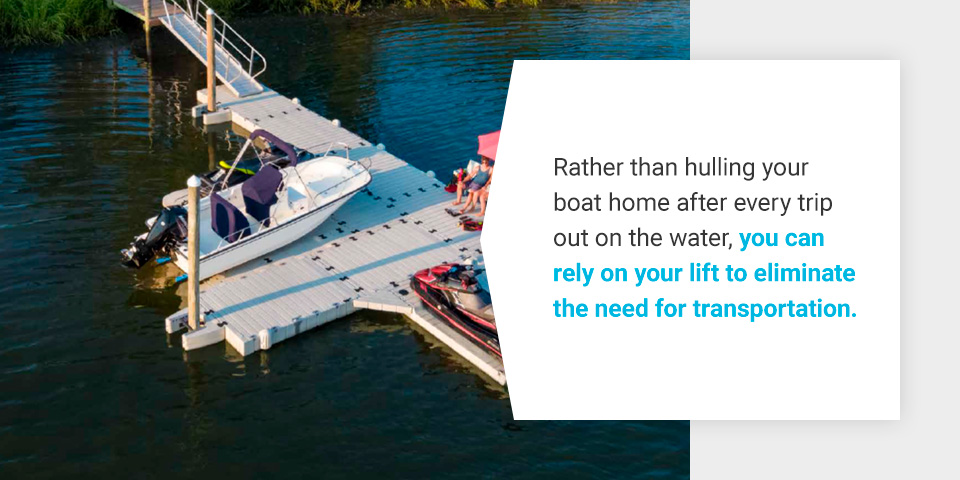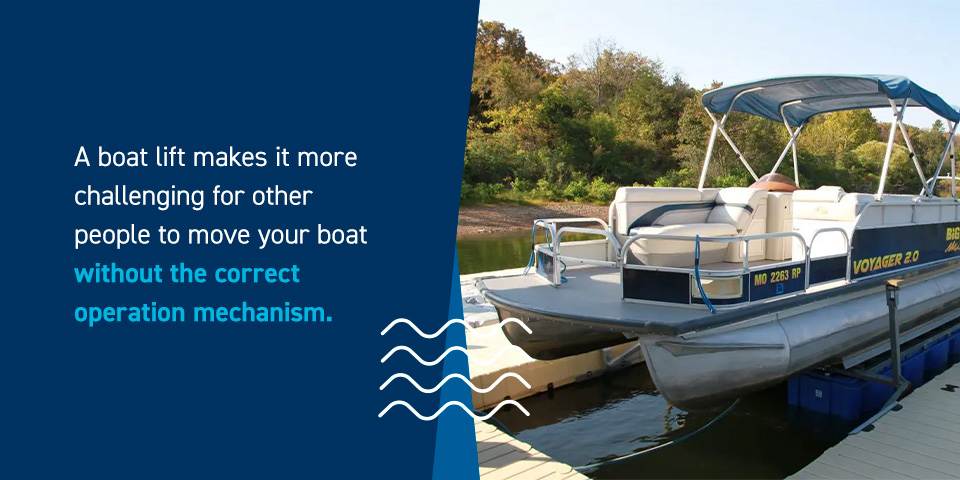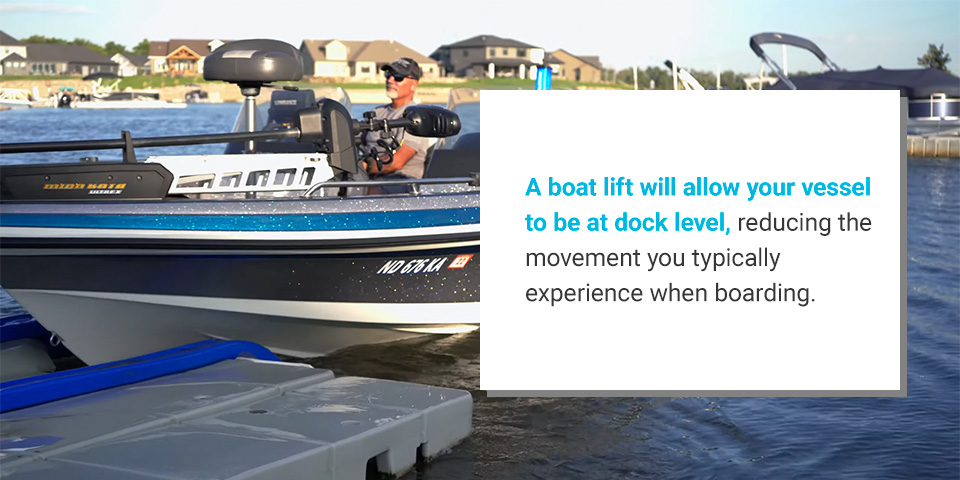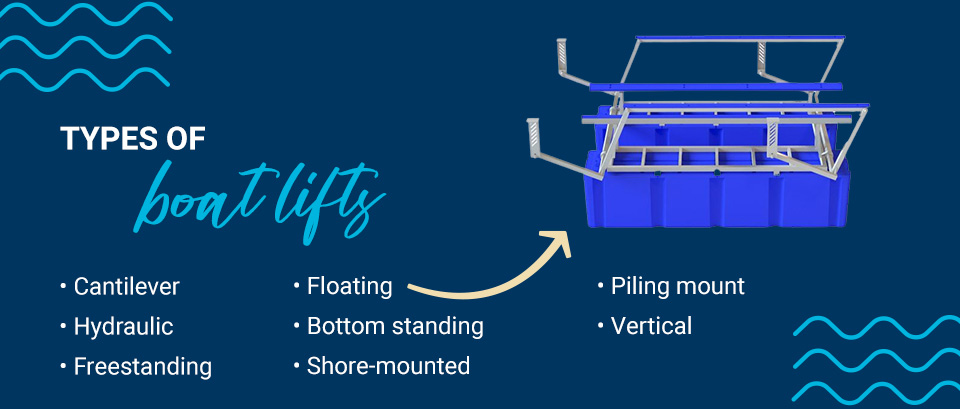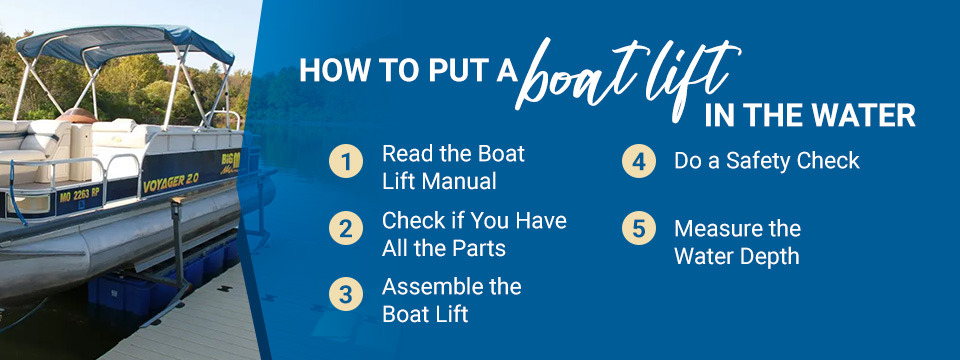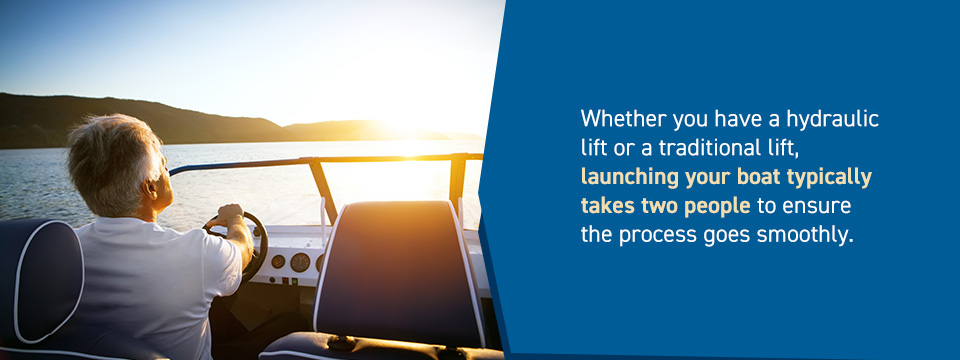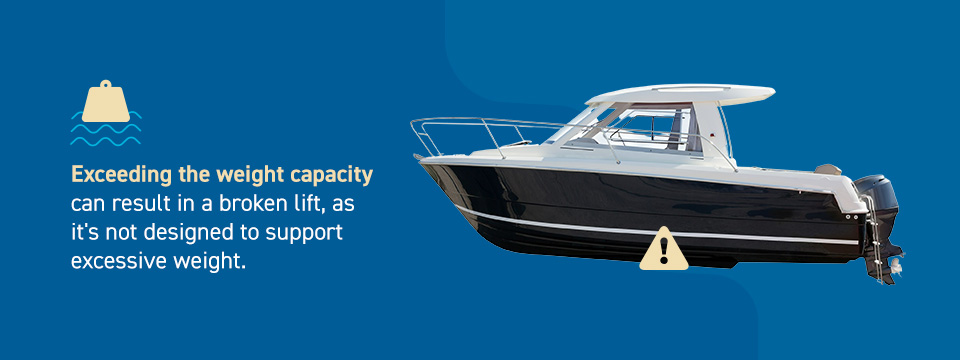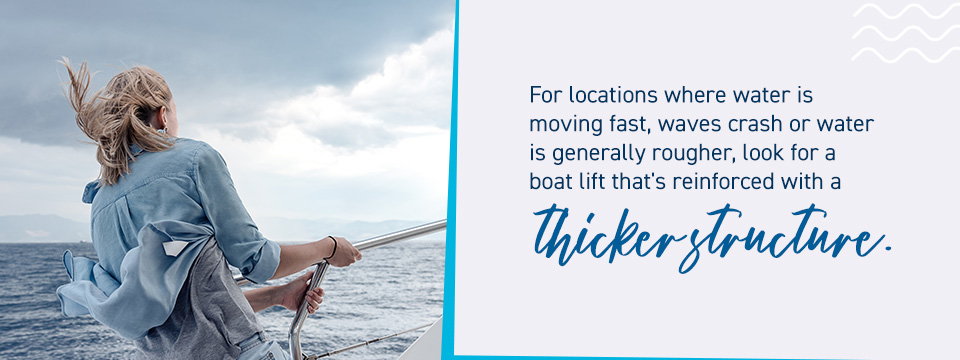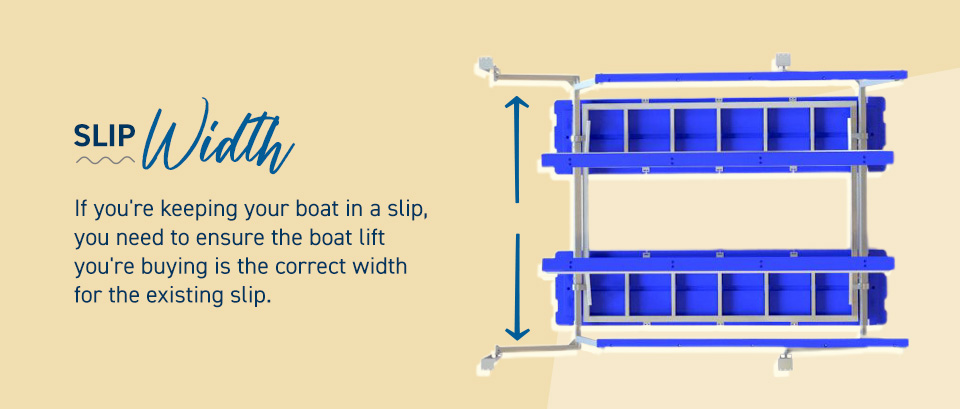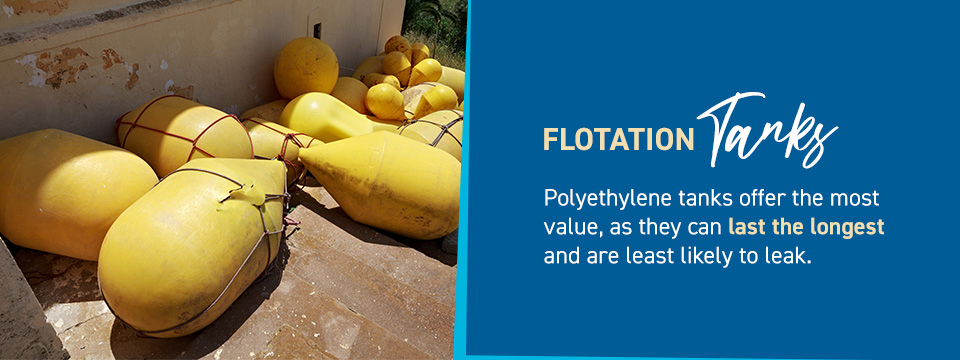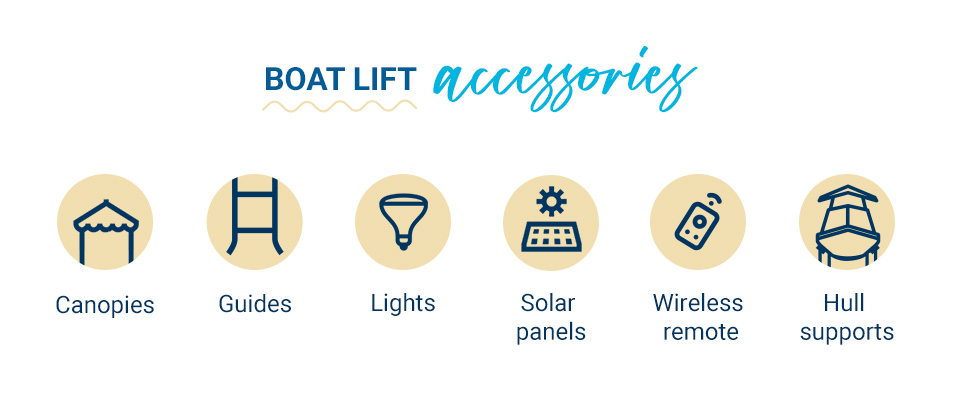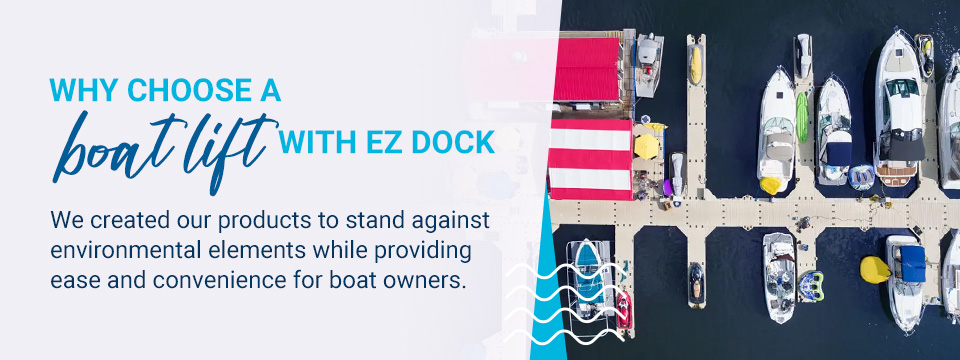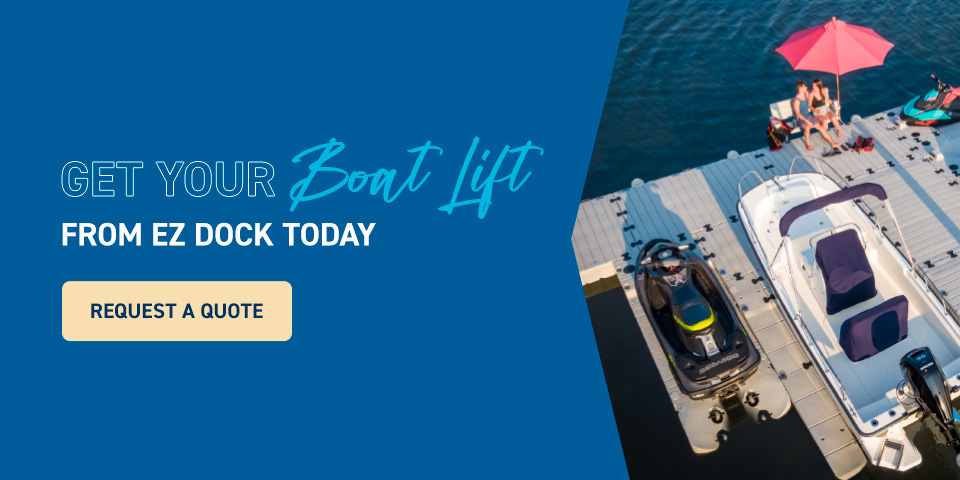Filters
Everything You Need to Know About Boat Lifts
Whether you’re a new boat owner or are looking for a new boat lift, there is a lot that goes into the different kinds of boat lifts, how to use them and how to find the best one for your situation. An adequate boat lift for your boat can protect your investment over time, reducing the need for costly maintenance and repairs.
Boat lifts offer many benefits, and you can find tons of accessories and add-ons to enhance your experience. Operating these systems can be easy, but there are several factors you must consider for safe and efficient operation. Learn how boat lifts can be beneficial as well as everything you need to know when buying a boat lift and how to operate it now.
Read the entire article or skip to a specific section:
- What Is a Boat Lift?
- The Benefits of a Boat Lift
- Types of Boat Lifts
- How to Put a Boat Lift in the Water
- How to Use a Boat Lift
- Boat Lift Safety Tips
- What to Consider When Buying a Boat Lift
- Boat Lift Accessories
- EZ Dock Boat Lifts
- Why Choose a Boat Lift With EZ Dock
- Get Your Boat Life From EZ Dock Today
What Is a Boat Lift?
A boat lift is a specialized equipment designed to elevate your boat out of the water, keeping it suspended above the water’s surface. While traditional boat lifts rely on manual crank and pulley systems, a modern boat lift works due to the motorized mechanisms, making the lifting process effortless. With the growing popularity of boat lifts among the boating community, you may have encountered or even used one before. These innovative devices offer a convenient solution for preserving your boat’s value and extending its lifespan, providing superior boat storage compared to keeping it constantly immersed in water.
When people first invented boat lifts, they required several people to operate. Early lifts used davits, or cranes, to lift the boats out of the water, which was difficult and time-consuming. Eventually, the cradle system did away with the davits, making the process simpler while providing more support for the boat. Another important development was the switch from steel to aluminum, as aluminum is less conducive to rust and can support significant amounts of weight while not being heavy itself.
Over time, aluminum has remained a sturdy material for boat lifts, and updates to the cradle system have made the lifts more efficient and effective. With boat lift technology continuously improving, they’re a beneficial device for most boat owners.
How Do Boat Lifts Work?
It’s important to know the different parts of a boat lift to understand how it works. Boat lifts have four main components that allow it to operate smoothly:
- Bunk or cradle: Your boat lift can either have a cradle or bunk, depending on the type of boat lift you choose. Cradles or bunks support the boat’s hull and hold it securely. These components can either be fixed or adjustable.
- Framework or structure: While some boat lifts have complete structures, others mainly form a frame. The structure or framework of a boat lift contributes to the overall stability of the lift, helping to hold the cradles or bunks in place.
- Winch system: The winch system consists of a winch, a spool and a cable or strap. These components work together to raise and lower the boat.
- Cables or straps: The straps or cables connect the boat to the boat lift and are designed to withstand the boat’s weight. This is one element of the boat lift that may need frequent inspection for wear and tear since they bear most of the weight.
When you load your boat onto the lift, it should settle directly on the cradles or bunk, which is secured in place by the framework or structure underneath it. The winch system then works to raise or lower the boat with its straps or cables, which wind around the spool to complete this function. While many lifts operate manually, some winch systems are hydraulic or electric for more convenience.
The Benefits of Boat Lifts
The concept of a boat lift is simple — it suspends the boat above water. Despite the simplicity, boat lifts offer crucial benefits for boat owners. These devices can help you create the ultimate water experience so you can maximize your time on the water and enjoy enhanced convenience. If you’re unsure about why you should use a boat lift, consider these benefits as reasons why a boat lift is worth having.
1. Protection From Corrosion and Algae
When you store your boat in the water for long periods, the underside of the hull and any submerged parts become highly susceptible to corrosion and algae buildup. Depending on the body of water the boat is sitting in, you may also have to deal with barnacles, zebra mussels or other unwanted aquatic life clinging to your hull. While algae and barnacles will inconveniently require a thorough scrubbing and cleaning, corrosion is a bit more serious and would require more extensive maintenance or repairs.
Proper cleaning and maintenance for these issues can get expensive and time-consuming. If you don’t address these issues, corrosion and algae buildup will ruin your boat. Storing your vessel in a boat lift that keeps the boat above water levels helps prevent these issues from occurring and can save you significant amounts of time and money in the long run.
2. Prevention Against Damage and Scuffs
Many boat owners who don’t own a lift simply keep their boat tied or anchored to their dock or the shore. Without the support of a boat lift to stabilize your boat during storage, rough waters and tide changes can push and pull the boat into the dock. In addition to cosmetic damage like scrapes and scuffs, your boat and dock can both incur serious damage from the boat knocking around. Any flood or storm debris and winter ice floating in the water could also cause scrapes and scuffs.
With a boat lift, your vessel will have secure support above the water to prevent it from rocking or floating into a dock or another nearby structure. Keeping the boat raised above the water also helps protect it from objects floating nearby.
3. Securing Your Boat
Keeping your boat lifted out of the water helps keep it from sinking or floating away, as long as you use the lift correctly. This benefit gives you the ultimate peace of mind that, even if you leave your boat lifted at the dock, it’ll stay safely suspended in the air.
4. Enhanced Convenience
A boat lift can save you time and make it easier to store your vessel. Rather than hauling your boat home after every trip out on the water, you can rely on your lift to eliminate the need for transportation. Additionally, you can save time by avoiding tying and untying boat bumpers and dock lines each time you want to get in or out of the water.
5. Preventing Theft
Water vessels can be an easy target for theft because there are many locations where security is minimal, such as private docks. A boat lift makes it more challenging for other people to move your boat without the correct operation mechanism. This can give you enhanced peace of mind and dissuade bad actors from targeting your property.
6. Creating a Quicker and Safer Way to Board
Keeping your boat in the water while getting on or off can be challenging for some passengers. The lack of stability and changing water levels can result in accidents, especially if you’ve invited many friends and family members to join your water adventure. A boat lift will allow your vessel to be at dock level, reducing the movement you typically experience when boarding.
Types of Boat Lifts
There are various boat lifts available with unique features to accommodate different boat types and sizes as well as ocean, lake and river bottoms. Here are some common boat lifts you may see along the shore.
Boat lift types include:
- Cantilever boat lifts: Cantilever boat lifts are one of the most common types of lifts because they’re relatively easy to maintain and can lift boats farther out of the water. These boat lifts use a cable to pull two H-shaped structures into a vertical position, leveraging the boat out of the water. Cantilever lifts are ideal for shallower water, as you’d be able to pull your boat farther out of the water than if it were in deep water.
- Hydraulic boat lifts: Hydraulic boat lifts utilize battery power, allowing you to raise and lower your boat with the push of a button. These lifts are thought of as premium because they’ll move your boat quickly and won’t make much sound when doing so. You can control many hydraulic lifts with a remote, further adding to their convenience.
- Freestanding boat lifts: While most boat lifts can connect or attach to your docking system, freestanding boat lifts provide another option. These lifts have a unique design, allowing them to stand alone, and you can use them on different bed surfaces like muddy lake beds or rocky river beds. Another benefit of freestanding boat lifts is that you can easily remove them because they don’t have attachments to any objects, making them ideal for cold climates where you’re not boating all year.
- Floating boat lifts: Floating boat lifts are exactly what they sound like — lifts that float on top of the water. Floating boat lifts can float next to a traditional dock or seamlessly connect to floating docks. Because they float, these lifts are great for deeper water or beds that make lift installation more challenging. They’re also pretty versatile, as they can accommodate a variety of boats.
- Bottom standing lifts: Bottom standing lifts are typically better for smaller and lighter boats and a water depth of 2 feet to 9 feet. These lifts stand on their own legs and are best installed next to the dock. If your boat has an even and firm bottom, it may be easier to load onto the lift.
- Shore-mounted lifts: This lift is a ramp that starts in the water near the shore and leads onto the shore. You drive your watercraft onto the ramp and then use the winch system to pull the boat up the ramp and out of the water.
- Piling mount lifts: Piling mounts offer a convenient way to withstand strong tides because of their durability. This lift is mounted in concrete on the pier with a strong structure that supports the boat. These lifts usually require custom installation and professional installation. Most of these lifts also need electric power to function.
- Vertical boat lifts: Does your lake or shoreline have a rough tide or large waves? Vertical boat lifts are the perfect solution because they can go up to 5 feet high and offer an easy way to access your boat from either side. Great for pontoon boats, these lifts can feature electric- or solar-powered winches or an automatic brake winch.
How to Put a Boat Lift in the Water
Installing a boat lift involves six crucial steps. Whether you can install it on your own or with professional help depends on the type of boat lift you choose. Either way, these six steps can be helpful in any boat lift installation process.
1. Read the Boat Lift Manual
Any boat lift installation can run much more smoothly when you follow the manufacturer’s manual. Manuals can offer step-by-step instructions with diagrams and images and any additional information you need to know about how the finished product should look and operate. It may also provide extra information about the lift’s warranty and what to do when certain issues arise.
Referring to the manual helps you install it correctly. If you install it incorrectly because you avoided checking the manual and damages occur later, the warranty might be void.
2. Check if You Have All the Parts
The manual might also come in handy by helping you identify all the boat lift parts. By inspecting this list and comparing it to the parts you received, you can take inventory and ensure all the relevant parts are present and in good condition. This is essential because damaged or missing screws or parts might compromise the safety of your lift and boat.
Be sure to take inventory before you begin assembling the lift. If there are missing or damaged parts, you can report it to the manufacturer and wait for them to deliver the requested parts without any extra steps in between, such as disassembling the parts you already put together.
3. Assemble the Boat Lift
During this critical step, you’ll want to follow the manual more carefully. Follow each step listed and ensure you fasten the various components securely enough that they will stay intact over time. If the instructions are confusing or you need assistance understanding what you need to do, you can always contact the manufacturer. It might also be helpful to check their website to see if they have videos demonstrating how it’s done or see how other customers assembled the same boat lift.
4. Do a Safety Check
Once you’re done assembling the boat lift, take some time to ensure everything is secure and working as expected. Here are some critical aspects that might need inspection:
- Crank: If you have a manual boat lift, you’ll want to ensure that the hand cranks or pulleys function correctly by checking if they begin to stick at any point or if there are snagging cables.
- Cable: If you install the cables and start to notice some fraying due to pressure, it’s best to call the manufacturer about the issue before it escalates.
- Motor: If you have an electric boat lift, make sure to care for it according to the manual and test that it works correctly before placing your boat in the lift.
5. Measure the Water Depth
Be sure to take measurements of the exact spot you would like your boat lift to occupy. How far should the end nearest to the shore be? How far should the end furthest from the shore be? Record these measurements and the depth of the spot for a faster and more accurate launch. Following this, you will be ready to place the boat lift in the water. If it is your first time doing so, it may be helpful to receive help from a professional to reduce any risks of injury.
How to Use a Boat Lift
Boat lifts are considered a machine, so it’s important to understand the proper way to use these machines to ensure safety. You need to know how to operate the lift, lower your boat into the water and how to park your boat in the lift when returning to shore. While you will need to operate different lifts in various ways, here are some basic steps to keep in mind:
- Boat lift operations: The main difference in how boat lifts operate how you use the mechanism to raise and lower the boat. Let’s say you have a hydraulic lift. You may have a control switch or up and down buttons. Regardless, to lower the boat, you’ll use the “down” control, and to raise the lift, use the “up” control. No matter the lift you choose, it’s best to read the owner’s manual for specific operating instructions.
- Launching your boat: Whether you have a hydraulic lift or a traditional lift, launching your boat typically takes two people to ensure the process goes smoothly. If you’re driving the boat, the other person should operate the lift. As they lower the cradle into the water, the boat will begin to move freely. This is when you’ll guide the boat off the lift and away from the launch. Make sure the boat is completely off the lift before operating it.
- Parking your boat: Parking your boat requires careful maneuvering. As you’re nearing the dock, consider your speed, the wind and waves, all of which could cause you to miss the lift or potentially hit another boat or dock. Approach the dock slowly with short touches of the throttle to maintain adequate speed. Your lift operator should ensure the lift cradle is low enough in the water so you can safely position the boat over it. Once you’re in the lift, your second person should raise the boat high enough to allow everyone to safely exit it. Leave the boat lift up when you’re not using it to prevent damage from the water, objects or marine life.
Launching your boat tends to be the easiest part, while parking can be a bit more of a challenge. While the process can feel overwhelming at first, you’ll soon gain experience and be able to use your boat lift like a pro. It’s also helpful to communicate with the lift operator so you’re both on the same page and know what the other person needs. If you need some help guiding the boat into the lift, ask the lift operator or other passengers to distribute their weight.
Boat Lift Safety Tips
Safety on the water is essential for any boating activity, and operating a boat lift is no different. Boat lift safety begins with proper use and maintenance of your lift. Maintaining safety throughout the boat lift process ensures you and your passengers remain safe while also protecting your boat, dock, lift and others surrounding them. Here are a few boat lift safety tips to keep in mind:
- Follow the weight limit: Every boat lift has a recommended weight capacity. This includes the weight of the boat and any passengers or gear inside it. Your boat lift capacity is in place to help ensure you use the lift properly. Exceeding the weight capacity can result in a broken lift, as this equipment does not possess a design to support excessive weight. Abiding by the recommended ratings ensures the lift can properly support the boat and will operate as it should. Additionally, consider leaving a significant margin of error when calculating the weight. Even a slight difference between your estimates can cause problems. If you’re in doubt about what you can fit on the boat, move on the side of caution to prevent damage.
- Perform routine maintenance checks: Since boat lifts sit in the water, they’re prone to wear and tear over time. Performing regular maintenance on your boat lift helps keep it in safe operating conditions. Routine maintenance checks can help you catch small problems before they become big issues. For example, cables are known to snap without warning, though routine checks may help you identify cables that are at risk of breaking and need to be replaced. It will also be beneficial to inspect and lubricate the winch system regularly to ensure it continues to operate smoothly.
- Understand proper positioning: Proper positioning of a boat in a lift has a lot to do with the boat’s weight. Excessive weight in the front or back of the boat can damage the respective cables if the boat is sitting too far forward or back in the lift. It’s best to ensure there is an even weight distribution throughout the boat. Additionally, make sure you’re positioning the boat in the center of the cradle to evenly distribute weight in the lift.
- Don’t lift your vessel too high: You only need to lift your boat so that it is out of the water. Always monitor the lift level, and raise your boat slowly. As you operate the lift, listen and look for signs of resistance or other issues that could indicate your system is straining. You can find some boat lifts with a limit switch to prevent causing damage due to over-raising to avoid this issue.
- Always operate your device with care: Although a boat lift can provide a faster alternative for entering and exiting your vessel, it is critical to always use care when operating it. You could cause a lift rack and frame to jam together if you try operating your lift without the proper care, causing a backfire with your cables. This could lead to damaged cables and other components and increase the risk of injury.
- Monitor frame and rack jams: If you ever find yourself in a situation where the rack and frame are jammed together, it’s essential to move quickly and safely. You must know which way the motor will turn when relieving pressure by flipping your switch. Starting the motor or winch in the wrong direction could cause your vessel to fall into the water, and you could experience damage almost instantly.
- Check state and community rules: Before getting a boat lift, it’s best to check your community’s rules and state laws to avoid running into issues later on. For example, South Dakota residents are restricted from placing a boat lift over public water unless they meet particular requirements.
Boat lift safety also ties into dock safety, as they’re often connected, so be sure to practice safety in all areas of boat use.
What to Consider When Buying a Boat Lift
Different types of boat lifts will be ideal for certain boats and water conditions. The best boat lift for any situation will vary depending on a number of factors. To ensure you’re buying a boat lift that will adequately meet your needs, keep these considerations in mind.
1. Location and Structural Strength
Where you plan to install your boat lift will determine the structural strength you’ll need for this mechanism. Every body of water has calm and rough areas, and some locations on the water are more prone to one or the other.
As you can imagine, rough water locations will inevitably lead to more wear and tear on the lift, requiring something more heavy-duty. For locations where water is moving fast, waves crash or water is generally rougher, look for a boat lift that offers reinforcement with a thicker structure. Stronger arms, mechanisms, bolts and bushings offer more support and bracing for those rougher areas of water. These lifts provide more support for your boat and dock, helping you save on maintenance costs.
As for calmer locations on a body of water, the same level of structural strength isn’t as necessary. Calm water creates less of a beating on the lift, dock and boat. Standard-built boat lifts should be sufficient if you’re in a calm water location. Keep in mind that some additional strength won’t hurt and will only provide value and quality to your setup.
2. Water Depth
Water depth can make a significant difference in whether you can get your boat on or off the lift. In locations where water depth is consistently low, certain boat lifts may stick out of the water too much, making it impossible to access your boat. You can expect the same for deep water, as certain lifts won’t raise your boat high enough.
If the water depth in your location is consistently low or high, look for a lift that’s designed for those depths. In other instances, water levels may rise and fall significantly, which can make finding the best lift a challenge. In these cases, consider how a floating dock could be beneficial, as it would rise and fall with the water levels, providing boat access in any tide.
3. Slip Width
A boat slip is like a parking space that’s cut out of a dock for your boat. They’re most common in marinas or if you have more than one boat because the dock runs around multiple sides of the vessel, offering extra protection and helping prevent bumping. If you’re keeping your boat in a slip, you need to ensure the boat lift you’re buying is the correct width for the existing slip. This is as simple as taking a few measurements ahead of time.
Choosing a lift with the right slip width will save you significant amounts of time and hard work. It also ensures the lift will fit right the first time, rather than needing to rework it.
4. Boat Size
The size of your boat is a huge determining factor when buying a boat lift. You need to be sure your boat will fit in the cradle and that the lift will be able to properly support the weight of your boat. Some boat lifts can accommodate a variety of different types of boats, while others are designed specifically for certain vessels. For example, pontoon boats typically require specific lifts.
You’ll want to consider the make and model of your boat as well as the dry weight and the weight of additional gear, fuel and propellers. These numbers will help you choose a lift with the right size and cradle shape to accommodate your specific boat. Be sure to also consider the boat’s length, as you want to ensure the lift is long enough so neither end of the boat hangs over the lift too far.
5. Flotation Tanks
Flotation tanks provide support and stability for a boat lift in deeper water. Boat lifts can sit on top of the tanks to help hold them up. If your boat lift setup requires flotation tanks, be sure to consider the material they’re made of. You should avoid metal tanks, as they’ll inevitably corrode, leaving you to obtain a replacement. Polyethylene tanks offer the most value, as they can last the longest and are least likely to leak.
Also, pay attention to the shape of the tanks — many are either cylinders or square. Square tanks tend to cost less and are ideal for calm waters. Cylinder tanks, though they cost more, can provide better stability. Cylinder tanks also displace the water to make sure all of the boat parts are up. For larger vessels, these tanks can allow the boat to sit more level and work better for the vessel’s center of gravity so the lift doesn’t lean or apply significant pressure to the back end.
6. Functionality
Aside from essential functionality, you also need to consider what features will make your boat lift more convenient for you. For example, a standard boat lift might come with manual control features, but you may prefer a remote-controlled boat lift.
You might also be able to choose between solar models and air-assist pumps or seek a boat lift with adjustable bunk locations for particular types of boats. Checking with various boat lift providers whether they offer customizations based on your unique needs may also help to get suitable functionality. Working with a dock and boat lift company like EZ Dock is a great way to leverage all these benefits.
Boat Lift Accessories
Boat lift accessories can help improve your lift and the way you use it. There are many options, allowing you to customize your lift depending on your needs and preferences. Here are a few accessories boat owners often get:
- Canopies: Canopies are one of the most common boat lift accessories. They hang over the boat lift, covering your boat and protecting it from precipitation, sun and birds. While you may put covers on your boat for long periods of unuse, canopies offer great coverage when you don’t have boat covers on and provide an extra layer of protection when you do use covers.
- Guides: Guides are aides that assist you when launching or parking your boat on the lift. From bow guides to full-length guide systems, guide-ins can increase the safety and ease of navigating your boat.
- Lights: Consider adding floodlights to your setup to increase visibility in dark conditions. Whether you’re heading out for an early morning on the water or are docking after dark in the evening, lights can help you safely maneuver your boat.
- Solar panels: Whether you’re using lights or your boat lift is battery-powered, solar panels are a great accessory that will help power your setup. This is a beneficial alternative to running electricity down to your dock, too.
- Wireless remote: Wireless remotes are a convenient way to control your equipment. Although many boat lifts offer this convenience, it can be beneficial to opt for a spare in case you forget, damage or lose your existing remote. Additionally, this simple switch can transform your water experience if you don’t have a remote control. Some remotes offer enhanced features, such as controlling your lights or raising or lowering the boat from several hundred feet away.
- Hull supports: Your vessel deserves optimal support on your lift. There are several types of hull support you can consider to ensure your boat has what it needs. You may opt for cradles to stabilize the hull. You can find adjustable cradles for horizontal and vertical use. Full-length bunks are another accessory to consider. These items can contour to your vessel for maximum stability and support. Consider a pontoon bunk for your vessel if you have a pontoon boat.
EZ Dock Boat Lifts
The newest boat lift from EZ Dock, the Aegis 7, uses a boat lift tank system with polyethylene precision-molded tanks to raise and lower your boat into the water. The air pumps are capable of lifting boats up to 28 feet long and 7,000 pounds in weight. You can customize the bunk to a variety of different hull configurations. Its bearing surfaces are high-strength with corrosion-resistant machinery to provide a reliable lift and minimize maintenance issues.
This easy-to-use boat lift is just one of many products EZ Dock offers for docking your boat. From boat ports to kayak launches, EZ Dock simplifies how you can gain access to the water.
Why Choose a Boat Lift With EZ Dock
EZ Dock began its story when traditional docks weren’t providing the support we needed. Traditional wooden systems require paint and repairs that cause you to spend less time in the water and more time worrying about your dock. These systems also caused several environmental concerns and didn’t fare well in storms. We created our products to stand against environmental elements while providing ease and convenience for boat owners. Our goal was to develop attractive, practical and eco-friendly systems for water enthusiasts.
We understand that one-size-fits-all solutions don’t work, and we designed our products to last to empower you to get the most out of your boating experience. Our customizable and versatile solutions suit PWC owners, kayakers and many other boat lovers.
Get Your Boat Lift From EZ Dock Today
We’re proud of our products and offer unbeatable value when it comes to long-term investments for your vessel. EZ Dock is an industry leader in floating modular docks, offering a vast selection of dock systems, PWC and boat lifts and accessories. Our products combine stability, strength and simplicity to provide incredible solutions for residential and commercial markets.
Whether you have a traditional dock system or an EZ Dock floating dock system, you can integrate our boat lifts and ports with your dock to provide easy boating access. Our boat lifts will help protect your boat and docking system so you can enjoy the simplicity of boating with a reduced risk of damage for years to come.
Request a quote from EZ Dock to find long-lasting, durable products that fit within your lifestyle.

